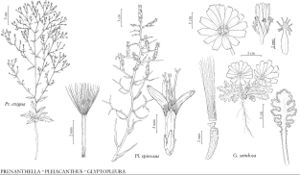Prenanthella
Bull. Torrey Bot. Club 33: 160. 1906.
| Taxon | Illustrator ⠉ | |
|---|---|---|
 | Prenanthella exigua Pleiacanthus spinosus Glyptopleura setulosa | Yevonn Wilson-Ramsey Sheila Flinchpaugh John Myers |
Annuals, 5–30 cm; taprooted. Stems 1–5+, erect (leafy proximally, often flexuous distally), branched near base bases or distally, glandular-puberulent to glabrescent. Leaves basal or proximally cauline; sessile or petiolate; blades spatulate to oblanceolate, often runcinate, margins irregularly dentate to lobed, teeth often spinulose (faces glabrous). Heads (10–150+, on flexuous, bracteate, intricately-branched axes) in paniculiform arrays. Peduncles not inflated, minutely bracteate. Calyculi of 2–3, minute, deltate, unequal bractlets. Involucres ovoid, cylindric at flowering, 2–3 mm diam. Phyllaries 3–5 in 1 series, linear-lanceolate, equal, herbaceous, margins hyaline, apices acute. Receptacles flat, smooth (with scars), glabrous, epaleate. Florets 3–4; corollas pink or white (slightly surpassing phyllaries at flowering). Cypselae pale-brown, columnar, tapering slightly proximally, not beaked, 5-ribbed and grooved, minutely rugulose, glabrous; pappi tardily falling, of 80+, basally connate, white, unequal, stiff, smooth bristles. x = 7.
Distribution
sw United States, nw Mexico
Discussion
Species 1.
The single species of Prenanthella was usually assigned to Lygodesmia in treatments prior to A. S. Tomb’s (1972b) reassessment. Its base chromosome number of x = 7 was taken as evidence of a possible relationship with Malacothrix, Calycoseris, and Anisocoma, also x = 7 (Tomb 1974). Recent molecular phylogenetic studies (J. Lee et al. 2003) place Prenanthella in a clade with Pleiacanthus, Stephanomeria, and Rafinesquia, all with x = 8. This group, together with Munzothamnus, constitutes the subtribe Stephanomeriinae of Lee and B. G. Baldwin (2004).
Selected References
Lower Taxa
"fine" is not a number.